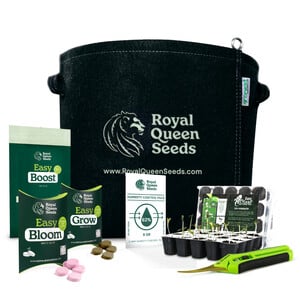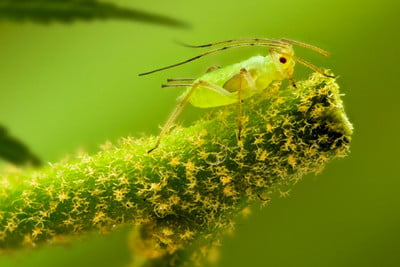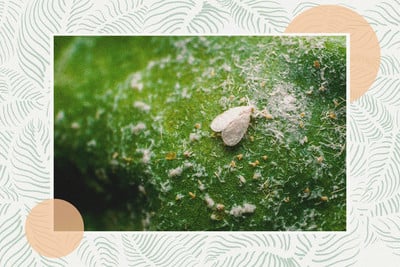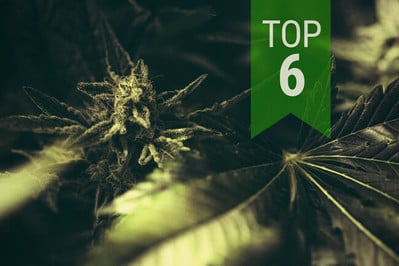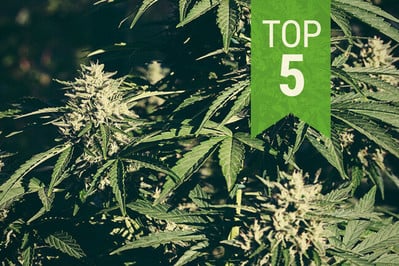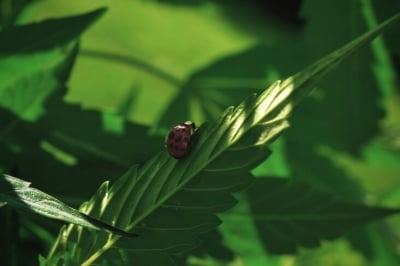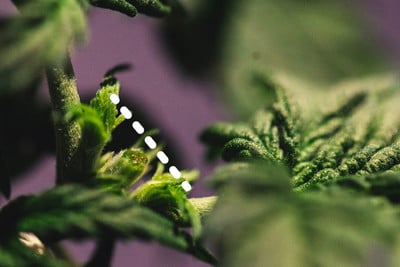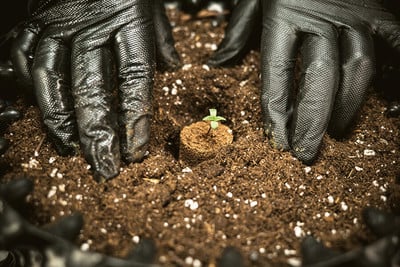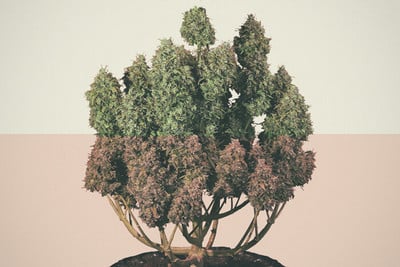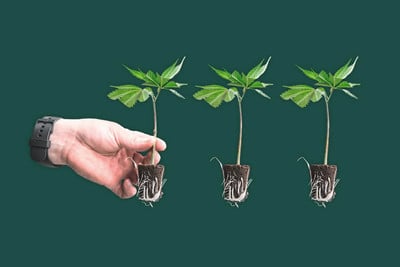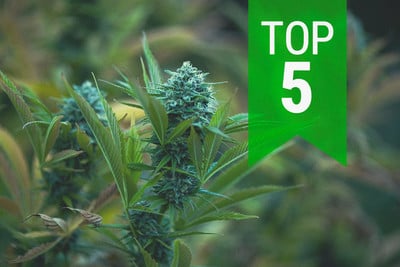 Cannabis Grow Guide by Royal Queen Seeds
Cannabis Grow Guide by Royal Queen Seeds
- Growing cannabis step by step
- Cannabis growing basics
- Choosing your seeds
- How to germinate seeds
- The cannabis vegetative stage
- The cannabis flowering stage
- Harvesting cannabis
- Trimming, drying, and curing
- Choosing pots and soil
-
Growing indoors
- A Complete Overview Of Growing Cannabis Indoors
- Cannabis Cultivation Tips: How To Set Up Indoor Grow Lights
- How Many Cannabis Plants Can You Grow Per Square Metre?
- Indoor Cannabis Growing: Relative Humidity and Temperatures
- Hydroponics Cannabis Growing Guide (with diagrams)
- Cannabis Micro Growing: Growing Great Weed in Tiny Spaces
- Growing outdoors
- How to grow autoflowering cannabis
- Cannabis nutrients and pH
- Cannabis troubleshooting: Nutrients
-
Cannabis troubleshooting: Growing
- Cannabis Seed Germination — Troubleshooting Guide
- How to Deal With Pythium (Root Rot) in Cannabis Plants
- Slow Cannabis Plant Growth And What You Can Do About It
- How to Prevent and Fix Stretching in Cannabis Seedlings
- Watering Your Cannabis: How to Fix Overwatering and Underwatering
- Understanding Male, Female, And Hermaphrodite Cannabis
- Identifying and Treating Common Cannabis Ailments
- How To Revive a Sick Cannabis Plant
- How to Avoid Mouldy Weed During Drying and Curing
- How to Prevent and Treat Dry and Crispy Cannabis Leaves
- What Cannabis Leaves Can Tell You
- Causes and Solutions for Yellow Cannabis Leaves
-
Cannabis Strains Grow Report
- HulkBerry Automatic Grow Report
- Blue Cheese Auto Grow Report
- Purple Punch Automatic Grow Report
- Triple G Automatic Grow Report
- Do-Si-Dos Automatic Grow Report
- Green Gelato Automatic Grow Report
- Haze Berry Automatic Grow Report
- Purple Queen Automatic Grow Report
- Cookies Gelato Automatic Grow Report
- Sherbet Queen Automatic Grow Report
- Sweet Skunk Automatic Grow Report
- Medusa F1 Grow Report
- Cannabis plant training
-
Weed growing tips
- The Cannabis Plant Anatomy
- How to preserve seeds
- How Much Sunlight Do Outdoor Cannabis Plants Need To Grow?
- How to Control and Prevent Stretching in Cannabis Plants
- My Cannabis Plants Are Growing Too Tall: What Should I Do?
- Should You Worry About Purple Or Red Cannabis Stems?
- What To Do When Your Indoor Cannabis Won’t Flower
- How To Protect Your Cannabis Plants From Heat Stress
- How To Tell If Your Female Cannabis Plant Has Been Pollinated
- Growing Medical Marijuana
- Bud Washing: How to Clean Your Weed
- Understanding Cannabis Yield per Plant

Tips For Growing Autoflowering Cannabis Outdoors
Contents:
Autoflower cannabis strains are awesome. They grow fast and easy, and they fit pretty much everywhere because of their compact size. Although autoflowers are great for growing indoors, you can make the most of them with some love from Mother Nature outdoors.
Just a few years ago, many cultivators didn’t take autoflowers seriously. They saw them as something suited for beginners, as the first autoflowering varieties couldn’t really match the yield, aroma, and potency of photoperiod strains. But this has changed significantly in recent years. Modern autoflowers have great yields, and their buds are of a quality that rivals photoperiod strains. As such, it only makes sense that cultivators are growing these strains outdoors to make the most of their key features. Here are some benefits of outdoor-grown autos:
- Sunlight means better yields and fatter buds
- You can achieve several harvests in a single growing season
- You can grow them outdoors at any time of year (weather depending)
- They are less susceptible to pests due to faster growth
- They fit in tiny spaces on your balcony, terrace, or garden
- They are ideal for stealthy outdoor grows/guerrilla grows due to their small size
Inspired by the benefits of growing outdoors? Download our guide for straightforward tips to start your autoflower journey today!
Free RQS
Grow Guide!

Before you start — Planning your outdoor auto grow
One of the advantages of autos is their fast growth. Some autoflower strains can deliver their goods in an amazingly short 50–55 days from the moment you plant your seed. Although their very fast growth is normally an advantage, it also means that autos are less forgiving when it comes to certain mistakes, as you simply don’t have the time to correct things as you would with photoperiods. Likewise, if any major issues happen over their short lifetime, from diseases and overwatering to pests and whatnot, this will also greatly diminish your yield.
To avoid this, you want to carefully plan your autoflowering outdoor grow so your plants can reach their full potential in the short time they have. Before anything else, consider the viability of your location.
What’s the climate like?
Are you planning to plant your seeds directly in a garden bed or in containers?
What type of nutrients will you use? Will your plants get enough sunlight?
Will you be able to attend to your plants, or are you growing in a remote location where you can’t visit often?
For instance, if you happen to live in a colder, rainier climate, you may want to choose an autoflowering strain that doesn’t mind cooler temperatures and is also resistant to mould. Even these simple considerations can be enough to help you optimise your grow and avoid disaster.
When to plant your autoflowers outdoors
Photoperiodic cannabis relies on natural daylight hours for its vegetative and flowering stages. You normally plant seeds in late spring where they will veg until late summer when the shorter daylight hours force them into flowering. By the end of summer/early autumn, they will be ready for harvest.
The beauty of autoflowers is that they don’t rely on daylight cycles, which means you can plant and harvest autoflowers any time you want.
If you live in a climate where there is no frost, such as in the Mediterranean, you can, in principle, grow autoflowers all year round.
Then again, cannabis, including autoflowers, grows best when it can get at least 10–12 hours of sufficient sunlight. As such, it is still best to plant seeds in spring, sometime from late April to early May in Europe, as the days are already longer, which will benefit your plants’ growth. You can then harvest in late July and start another crop in early August, which will be ready in October. If you happen to live in a warm climate with no frost, you can reap up to four harvests in one single year!
If you live further north, you may want to avoid the coldest and rainiest months of the year. In these climates, you can plant your autoflowers sometime in late spring when you know there is no danger of frost. The exact time depends on where you live, and could range from April to early June. The shorter summer in a colder climate is also a factor you need to think about. You shouldn’t sow too late either, as you want to avoid flowering your weed into the rainy season. If you live somewhere with a rainy autumn, it can be good to plant in early June, so you can harvest late in August. This way, you can beat the bad weather and your buds won't autumn victim to mould.
Bottom line: The best time to plant will depend on the climate where you are growing. Ensure your plants can get plenty of sunlight, and make sure to avoid frost and extensive rain.
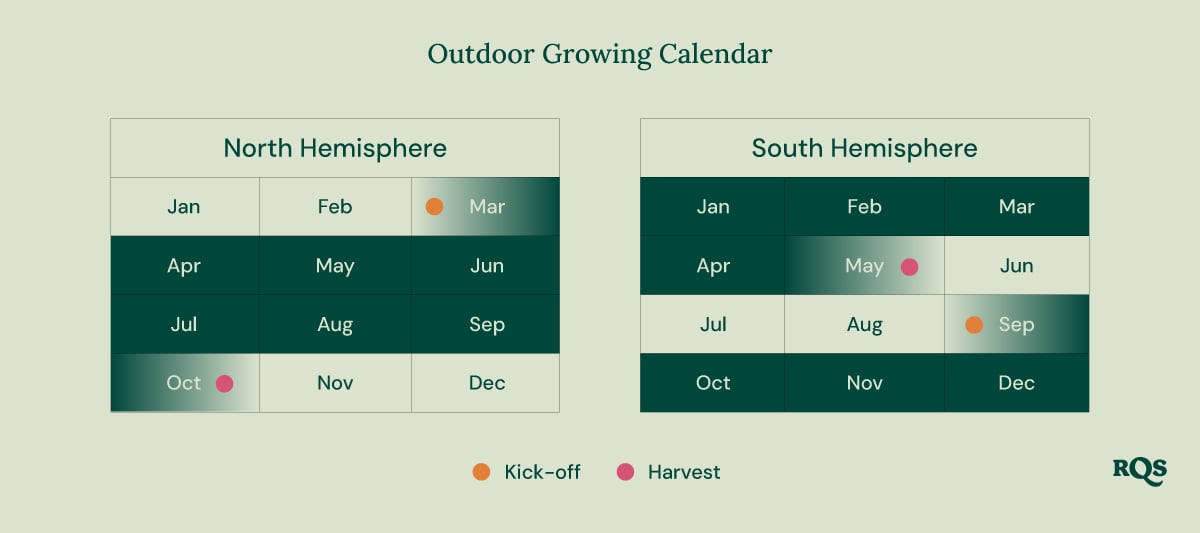
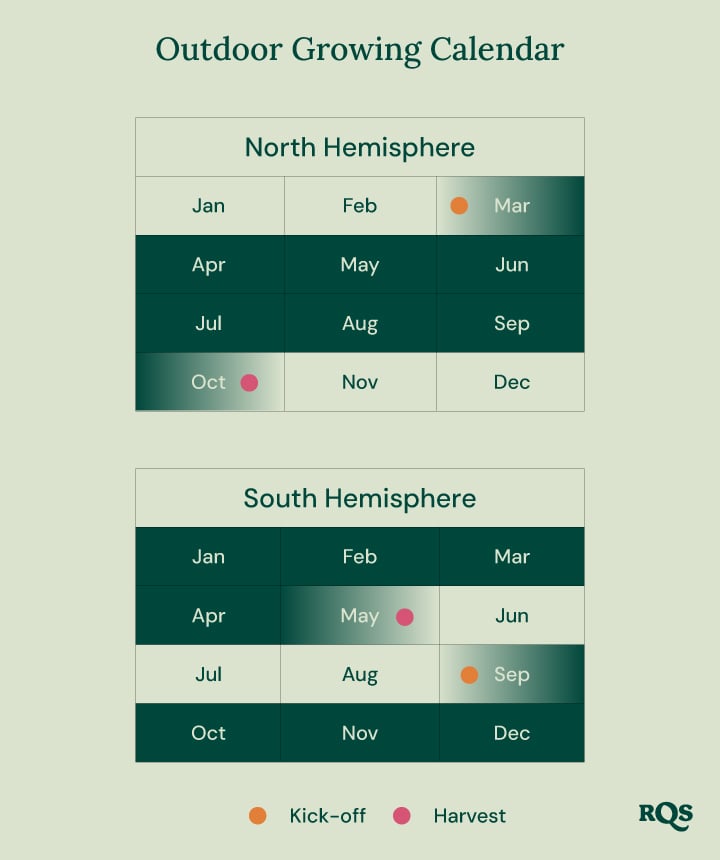
How to grow your outdoor autoflowers
These days, you can find many great varieties of autoflowering cannabis seeds. Check out Royal AK Automatic, Amnesia Haze Automatic, Northern Light Automatic and the many other great autoflowers at Royal Queen Seeds. Once you find a strain you like—one that will grow well in your climate—you can get started with your outdoor grow.
1. Germinate your autoflowering seeds

You can germinate your autoflowering cannabis seeds just like you would photoperiod seeds. Some cultivators like to germinate using the “paper towel method” or by putting seeds into a glass of water. But you can also plant your seeds right into their final container. Know that re-potting autoflowering cannabis is not recommended, as the transfer from a smaller to a larger pot can slow its growth. Since the growing time of autos is already limited, you want to avoid this as it can lead to a decreased yield.
For best results germinating your autoflowering seeds, we recommend the Starter Kit Autoflowering. This kit comes with everything you need to give your cannabis plants the best possible start in life.
2. Prepare your planting container or growing spot

If you are growing your autoflower in a container, make sure that you choose a big-enough pot. Although autoflowers can normally do well with smaller pots compared to some of the larger photoperiod ladies, you still don’t want to restrict their growth. A pot that holds 7–15 litres will do. Again, keep in mind that your chosen pot will also be your final pot.
If you don’t use a container and want to plant directly in soil instead, know that the outdoor soil at your chosen location may not be optimal. The natural soil will likely not have sufficient nutrients, and it may drain poorly and/or contain harmful microorganisms that adversely affect the growth of your plant. For these reasons, outdoor growers often first dig holes for their outdoor plants, which they fill with a suitable substrate before planting their seed.
3. Watering and nutrients for your outdoor autoflowers

As autoflowers normally grow to a smaller size, they will not need as much water as a vigorous photoperiod sativa, but you still want to make sure that your outdoor auto has enough to drink. How much and how often you need to water will once again depend on your climate and the needs of your individual plant. Just like with any other type of cannabis grow, you want to avoid overwatering in particular, although underwatering isn’t ideal either.
As for nutrients, here too you will want to be careful with how much you administer. You can always start with ½ or ¾ doses of nutes to make sure you’re not overloading your plants. You can also consider slow-release nutrients. These can be ideal when you grow outdoors in a location that you can’t always visit. When you amend your substrate with slow-release nutrients, your plant will get everything it needs, and you won't need to bother feeding it. All you need to do is water.
4. Harvesting your crop

Some autoflowers can be ready in a short 50–60 days, but there are also those that take longer, up to 80 days. Just like with photoperiod strains, you’ll know that harvest time is close when the initially white pistils on the buds start turning brown. To really see when it’s time to harvest, you should examine the trichomes of your cannabis plant. Trichomes are tiny, mushroom-shaped outgrows on the buds and sugar leaves of your plant. During growth, trichomes are crystal-clear at first. Later in flowering, the trichomes turn a milky white colour, then around harvest time, they turn from white to amber. You can’t really see the trichomes with the unaided eye, so use a jeweller’s loupe to get a close look at them. Cultivators often harvest when a certain percentage of the tiny “bubble heads” of the trichomes turn amber. At this point, the leaves of your plant will normally have started to turn yellow.
When you're ready to harvest, swiftly cut the branches with the buds off of your plant, and don’t waste a lot of time drawing unwanted attention. Once you’ve safely brought home your harvest, you can trim the buds further. Alternatively, you can hang the branches with buds still attached for drying.
Growing outdoors can come with its own potential problems. Unwanted discovery of your weed out in the wild is one of them, but there is also the risk of animals and insects taking a liking to your crops. Here’s what you can do about it.
Common problems when growing autos outdoors
With these tips, you can look forward to a bountiful harvest from your autoflowering cannabis outdoors.
Happy growing!
 Grow Guide Topic Finder
Grow Guide Topic Finder
- Growing cannabis step by step
- Cannabis growing basics
- Choosing your seeds
- How to germinate seeds
- The cannabis vegetative stage
- The cannabis flowering stage
- Harvesting cannabis
- Trimming, drying, and curing
- Choosing pots and soil
-
Growing indoors
- A Complete Overview Of Growing Cannabis Indoors
- Cannabis Cultivation Tips: How To Set Up Indoor Grow Lights
- How Many Cannabis Plants Can You Grow Per Square Metre?
- Indoor Cannabis Growing: Relative Humidity and Temperatures
- Hydroponics Cannabis Growing Guide (with diagrams)
- Cannabis Micro Growing: Growing Great Weed in Tiny Spaces
- Growing outdoors
- How to grow autoflowering cannabis
- Cannabis nutrients and pH
- Cannabis troubleshooting: Nutrients
-
Cannabis troubleshooting: Growing
- Cannabis Seed Germination — Troubleshooting Guide
- How to Deal With Pythium (Root Rot) in Cannabis Plants
- Slow Cannabis Plant Growth And What You Can Do About It
- How to Prevent and Fix Stretching in Cannabis Seedlings
- Watering Your Cannabis: How to Fix Overwatering and Underwatering
- Understanding Male, Female, And Hermaphrodite Cannabis
- Identifying and Treating Common Cannabis Ailments
- How To Revive a Sick Cannabis Plant
- How to Avoid Mouldy Weed During Drying and Curing
- How to Prevent and Treat Dry and Crispy Cannabis Leaves
- What Cannabis Leaves Can Tell You
- Causes and Solutions for Yellow Cannabis Leaves
-
Cannabis Strains Grow Report
- HulkBerry Automatic Grow Report
- Blue Cheese Auto Grow Report
- Purple Punch Automatic Grow Report
- Triple G Automatic Grow Report
- Do-Si-Dos Automatic Grow Report
- Green Gelato Automatic Grow Report
- Haze Berry Automatic Grow Report
- Purple Queen Automatic Grow Report
- Cookies Gelato Automatic Grow Report
- Sherbet Queen Automatic Grow Report
- Sweet Skunk Automatic Grow Report
- Medusa F1 Grow Report
- Cannabis plant training
-
Weed growing tips
- The Cannabis Plant Anatomy
- How to preserve seeds
- How Much Sunlight Do Outdoor Cannabis Plants Need To Grow?
- How to Control and Prevent Stretching in Cannabis Plants
- My Cannabis Plants Are Growing Too Tall: What Should I Do?
- Should You Worry About Purple Or Red Cannabis Stems?
- What To Do When Your Indoor Cannabis Won’t Flower
- How To Protect Your Cannabis Plants From Heat Stress
- How To Tell If Your Female Cannabis Plant Has Been Pollinated
- Growing Medical Marijuana
- Bud Washing: How to Clean Your Weed
- Understanding Cannabis Yield per Plant


























